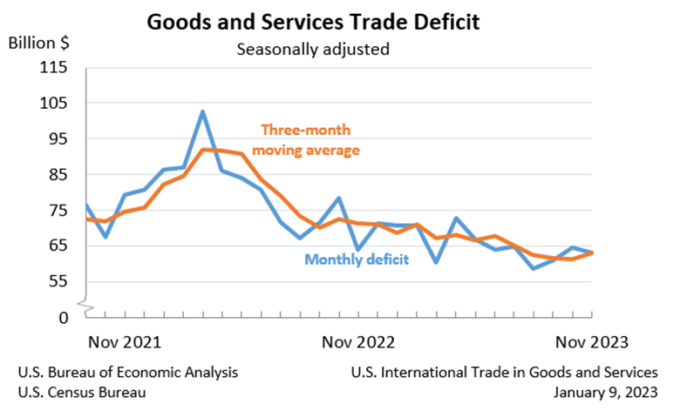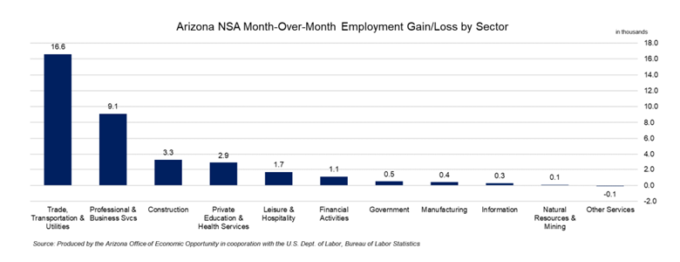EBRC Research Staff
Current data releases as of 12 January 2024
Arizona bankruptcy filings rose 7.2% in 2023 after three years of decreased activity. Both Chapter 7 (liquidation) and Chapter 13 (individual debt) were up over the year by 7.3% and 7.2%, respectively. Chapter 11 (reorganization) was flat, with one more filing in 2023 than in 2022. Of the 9,601 total bankruptcies filed in Arizona during 2023, 3.1% were business filings, up from 2.5% in 2022. By county, the number of bankruptcies ranged from a single filing in Greenlee to 6,304 in Maricopa. The Apache (50.0%) and Coconino (48.8%) counties had the largest percentage increase in bankruptcies while Santa Cruz, Cochise, Navajo, and Greenlee all experienced a decrease in the number of filings from one year to the next. The Tucson office had 9.2% more bankruptcies in 2023 than the year prior while Yuma had a 6.0% increase. The Phoenix and Prescott offices combined had a 6.5% increase from one year to the next. The two offices have historically been reported as one unit; however, now that they are reported separately, the Phoenix office increased by 5.7% and the Prescott office (representing Coconino and Yavapai counties) increased by 25.0%. –Valorie Rice
Arizona population estimates for 2023 were released in mid-December from the Arizona Office of Economic Opportunity. Arizona had a population of 7,525,113 on July 1, 2023, a 1.6% increase over 2022. Pinal County had the biggest percentage gain in population in 2023, increasing by 3.0%, aided by gains for Coolidge and the portion of Queen Creek within Pinal County, which both had population increases of more than ten percent. Yuma at 2.1% and Santa Cruz at 2.0% had the next highest increases in population. Gila was the only county to experience a loss in population with a 0.1% change as most of the incorporated places in the county had fewer people in 2023. [Note: EBRC presents population from the Arizona Office of Economic Opportunity on its indicator pages as it considers it more realistic for Arizona. The percentage increase presented here was larger than what the U.S. Census Bureau population estimates indicated for Arizona.] –Valorie Rice
The U.S. Census Bureau released July 1, 2023 state population estimates on December 19. The Census Bureau estimates indicated that the Arizona population increased by 0.9% between 2022 and 2023, slightly higher than the national increase of 0.5%. Arizona was among the states with the largest numeric growth over the year and remained the 14th most populated state in 2023. Along with the total population, the estimates included the percentage of each state’s population that was 18 years and over, or voting age. The percent of the resident population aged 18 years and over in Arizona was 78.7%, making the state’s population just a bit older than the U.S. at 78.3%. The state with the oldest population was Vermont at 82.3% while Utah was at the other end of the spectrum with 72.7% of the population aged 18 or over. --Valorie Rice
The monthly Consumer Price Index rose 0.3% in December on a seasonally adjusted basis after rising 0.1% in November and holding steady in October. The shelter index was a significant contribution to the overall increase in December. The energy index increased 0.4% over the month, though it was electricity prices rather than gasoline that pulled that up. The index for all items less food and energy was 0.3% for the month. The annual inflation rate stood at 3.4% for December, a bit higher than the 3.1% 12-month change posted in November. The index for all items less food and energy rose 3.9% over the year in December. Phoenix inflation continues to trend down with the December 12-month change at 2.7% compared to 2.9% in October and 3.7% in August. This was the smallest increase in prices for Phoenix since January 2021. –Valorie Rice
Use your cursor as a tooltip to switch series ON/OFF at the bottom of the chart. Run your cursor over the chart to view values.
Producer prices dropped 0.1% in December on a seasonally adjusted basis based on the January 12 Producer Price Index report from the U.S. Bureau of Labor Statistics. Final demand goods were down 0.4%, most of which can be attributed to a 1.2% drop in final demand energy prices. Final demand services remained flat for December, in fact was unchanged for the entire third quarter of 2023. The unadjusted 12-month change in final demand was 1.0% for December compared to December 2022 when the 12-month change was 6.4%. –Valorie Rice
The November goods and services deficit came in at $63.2, down $1.3 billion from a revised $64.5 billion in October. November exports fell $4.8 billion from October to $253.7 billion, and imports similarly fell $6.1 billion to $316.9 billion. The reduction in the deficit reflects a decrease in the goods deficit of $0.6 billion to $89.4 billion and an increase in the services surplus of $0.7 billion to $26.2 billion. Over the year, the goods and services deficit decreased $161.8 billion, or 18.4%. Exports increased $28.8 billion (1.0%), and imports decreased $133.0 billion (3.6%). South and Central America ($4.1), Netherlands ($3.0), and Hong Kong ($3.0) have the greatest surpluses, while China ($21.5), the European Union ($15.6), and Mexico ($13.8) have the greatest deficits (in billions). –Delaney O’Kray-Murphy
The U.S. unemployment rate remained unchanged in December at 3.7%, while total nonfarm payroll jobs increased by 216,000, according to the Bureau of Labor Statistics January 5th employment situation summary. Job gains occurred in government (+52,000), leisure and hospitality (40,000), health care (38,000), social assistance (21,000), retail trade (17,000), construction (17,000), and professional and business services (13,000). Employment declined in transportation and warehousing by 23,000. In December, average hourly earnings on private payrolls rose by 15 cents, or 0.4%, to $34.27. Over the year, average hourly earnings have increased by 4.1%. The average workweek for private nonfarm jobs edged down by 0.1 percentage points to 34.3 hours. This publication also revised the total nonfarm employment downward in both October and November by 45,000 and 26,000 to +105,000 and +173,000, respectively. –Delaney O’Kray-Murphy
Total Nonfarm Employment in Arizona increased by 60,000 jobs over the year in November. The seasonally adjusted unemployment rate rose 0.1 percentage points to 4.3% for the month. The U.S. seasonally adjusted unemployment rate decreased slightly in November to 3.7% from 3.9% in October. Arizona’s non-seasonally adjusted total nonfarm employment increased by 35,900 jobs in November, beating the pre-pandemic average of 28,800. Employment gains were reported in trade, transportation & utilities (16,600), professional & business services (9,100), construction (3,300), private education & health services (2,900), leisure & hospitality (1,700), financial activities (1,100), government (500), manufacturing (400), information (300), and natural resources & mining (100). Employment losses were only seen in other services (-100). Over the year, private education & health services saw the greatest increase (21,800), and other services saw the greatest decrease (-4,000). –Delaney O’Kray-Murphy
In November, over-the-month state unemployment rates were higher in 12 states and stable in the remaining 38 and the District of Columbia. Arizona saw a seasonally adjusted 0.1 percentage point increase in unemployment to 4.3%. Maryland had the lowest jobless rate in November at 1.8%, followed by North Dakota at 1.9%. Nevada had the highest unemployment rate at 5.4%. Over the year, 20 states saw unemployment rate decreases, 15 states and the District of Columbia saw unemployment rate increases, and the remaining 15 did not see notable changes. Arizona saw a 1.8% increase in employment, growing 54,800 jobs from November 2022 to the same period in 2023. –Delaney O’Kray-Murphy
In November, over-the-year metropolitan unemployment rates were higher in 214 of the 389 metropolitan areas, lower in 158, and unchanged in the remaining 17. The November unemployment rate for the Tucson and Phoenix metropolitan areas came in at 3.8% and 3.5%, respectively. Yuma had the highest unemployment rate in Arizona at 14.1%, and Prescott had the lowest at 3.4%. Farge, ND-MN, had the lowest unemployment rate in the nation at 1.3%, while El Centro, CA, had the highest unemployment rate at 18.7%. Kahului-Wailuku-Lahaina, HI, had the largest over-the-year unemployment rate increase with +2.5 percentage points, and Grants Pass, OR saw the most significant decrease at -1.8 percentage points. –Delaney O’Kray-Murphy
U.S. house prices had a one-year gain of 4.8% in October based on the S&P CoreLogic Case-Shiller Index released on December 26. Phoenix house prices gained 0.9% over the year in October after experiencing negative year-over-year price changes over several months. Detroit had the highest annual gain of all 20 cities for the second month in a row at 8.1% followed by San Diego at 7.2% and New York at 7.1%. The only city reporting lower prices over the year in October was Portland with -0.6%. –Valorie Rice
The November 2023 release of the Job Openings and Labor Turnover (JOLTS) report stated that the number of job openings in the U.S. changed little to 8.8 million, while the job openings rate was unchanged at 5.3%. The industry that saw the largest increase in job openings was wholesale trade at 63,000. The industry with the largest decrease was transportation, warehousing, and utilities with -128,000 followed by federal government at -58,000. The number of hires decreased to 5.5 million, with a seasonally adjusted rate of 3.5% for November, 3.7% for October, and 3.8% for September. Total separations in the nation decreased to 5.3 million, with a rate of 3.4%. The number of quits changed little, down to 3.5 million with a rate of 2.2%, respectively. The number of layoffs and discharges changed little at 1.5 million with an unchanged rate of 1.0%. The number of other separations in the U.S. was little changed, reporting at 342,000. –Alex Jaeger







